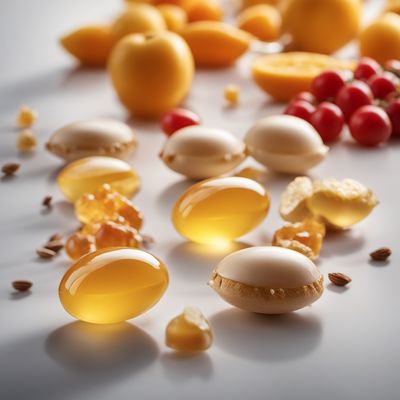
Ingredient
Caffeine
The Energizing Elixir: Unveiling the Power of Caffeine
Caffeine is a bitter, white crystalline powder that is most commonly extracted from coffee beans, tea leaves, and cacao beans. It is known for its stimulant effects on the central nervous system, helping to increase wakefulness and reduce fatigue. Caffeine has a slightly bitter taste and is often described as having a mild, nutty flavor. In its pure form, caffeine is odorless and highly soluble in water.
Origins and history
The use of caffeine dates back centuries, with its origins traced to ancient civilizations in East Africa and the Middle East. Coffee, one of the primary sources of caffeine, was first cultivated in Ethiopia and later spread to the Arabian Peninsula. Over time, coffeehouses became popular gathering places for socializing and intellectual discussions. Today, caffeine is consumed worldwide and plays a significant role in various cultures and traditions. From morning rituals to afternoon tea breaks, caffeine has become deeply ingrained in our daily lives.
Nutritional information
Caffeine is a natural stimulant that can increase alertness, improve focus, and reduce fatigue. It is also known to enhance physical performance and may have potential health benefits when consumed in moderation. However, excessive consumption of caffeine can lead to side effects such as restlessness, insomnia, increased heart rate, and digestive issues. It is important to be mindful of your caffeine intake and listen to your body's response.
Allergens
Caffeine is naturally present in coffee, tea, cacao beans, and some soft drinks. It is also added to certain medications, energy drinks, and dietary supplements. Individuals who are sensitive to caffeine or have certain medical conditions should consult with a healthcare professional before consuming products containing caffeine.
How to select
When selecting caffeinated products, consider the source and quality of the ingredient. Opt for high-quality coffee beans, tea leaves, or cacao products from reputable brands or specialty shops. Look for products that are labeled as organic or fair trade, as they often prioritize sustainability and ethical practices. Additionally, pay attention to the roast level of coffee beans, as it can affect the flavor and caffeine content. For tea, choose loose-leaf varieties for a more flavorful and customizable experience.
Storage recommendations
To maintain the freshness and quality of caffeinated products, store them in a cool, dry place away from direct sunlight. Coffee beans and ground coffee should be stored in airtight containers to prevent exposure to moisture and oxygen. Tea leaves should be stored in sealed containers or resealable bags to retain their aroma and flavor. It is best to consume caffeinated products within a reasonable timeframe to ensure optimal taste and potency.
How to produce
Caffeine is primarily produced on a commercial scale by extracting it from coffee beans, tea leaves, or cacao beans. However, it is not feasible for amateurs to produce caffeine at home due to the complex extraction process and specialized equipment required. Instead, individuals can focus on brewing their own coffee or tea using high-quality ingredients and experimenting with different brewing methods to achieve their desired flavor and caffeine strength.
Preparation tips
When preparing coffee or tea, follow the recommended brewing instructions for the specific type and brand of product. Experiment with different brewing methods, such as pour-over, French press, or espresso, to achieve your preferred strength and flavor. For coffee, consider grinding the beans just before brewing to maximize freshness. When making tea, adjust the steeping time and water temperature based on the type of tea leaves to achieve the desired flavor profile. Additionally, explore various coffee or tea recipes, such as iced coffee, lattes, or herbal infusions, to expand your repertoire of caffeinated beverages.
Culinary uses
Caffeine is widely used in the culinary world and can be found in a variety of beverages and food products. Coffee is the most popular source of caffeine and is enjoyed in various forms, including espresso, cappuccino, and iced coffee. Tea, both black and green, is another common source of caffeine and is often consumed hot or iced. Caffeine is also added to energy drinks, soft drinks, chocolates, and certain desserts to provide a stimulating effect. Its bitter taste and stimulating properties make it a versatile ingredient in both sweet and savory recipes.
Availability
Caffeine is globally available and consumed in almost every country. Coffee and tea are the most widely consumed caffeinated beverages, with significant variations in preferences and consumption habits across different regions and cultures.
More ingredients from this category

Phytochemicals
The Power of Plant Compounds: Unleashing the Potential of Phytochemicals

Co-factors to metabolism
The Essential Helpers: Unveiling the Co-factors that Fuel Metabolism

Special fatty acids
The Power of Special Fatty Acids

Taurine
The Energizing Amino Acid

Algae based fortifying agents (e.g. Spirulina, chlorella)
Nutritional Powerhouses from the Sea

Chemical elements
The Building Blocks of the Universe

Dietary fibre
The Digestive Champion

Bee-produced fortifying agents
Nature's Nutritional Powerhouses

Vitamins
"The Essential Nutrient Powerhouses: Unveiling the Secrets of Vitamins"

Glucosamine
The Joint Savior